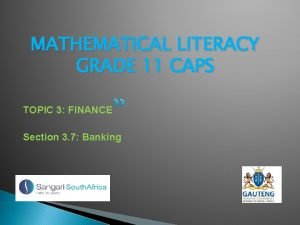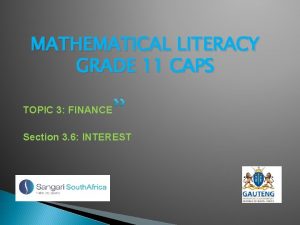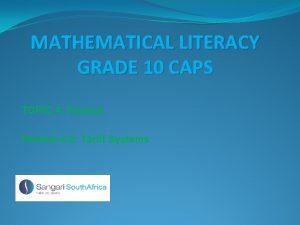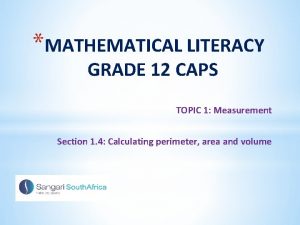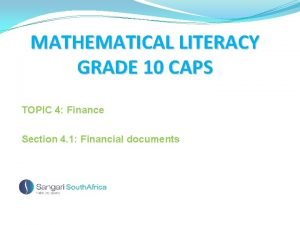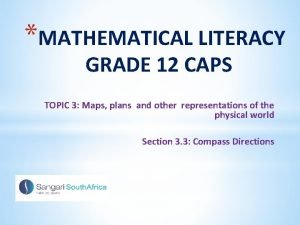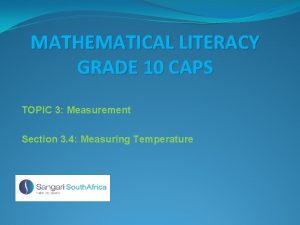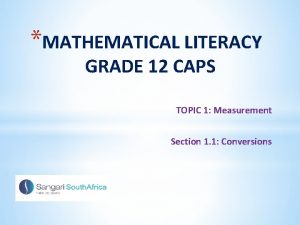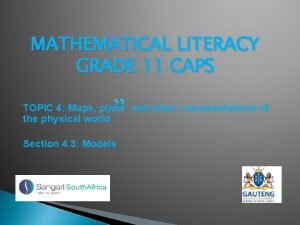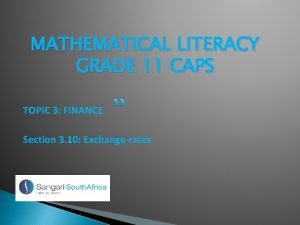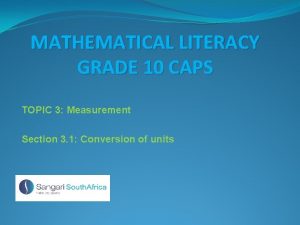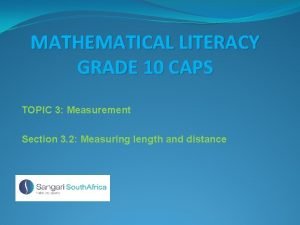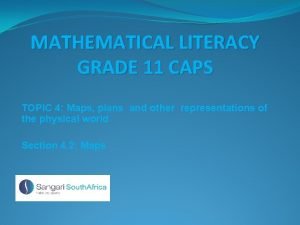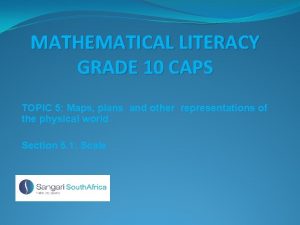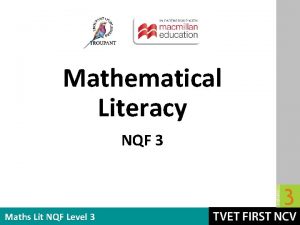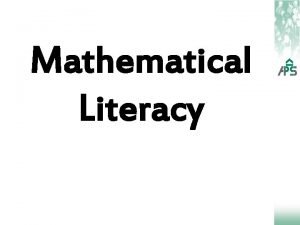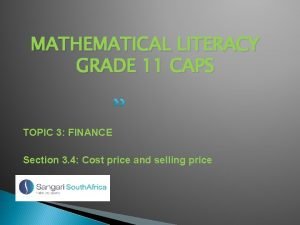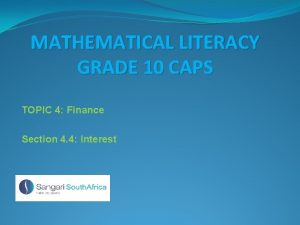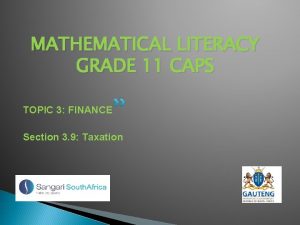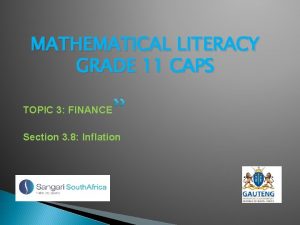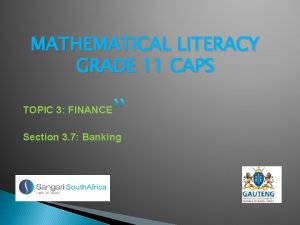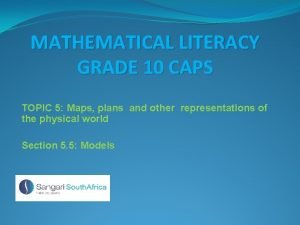MATHEMATICAL LITERACY GRADE 10 CAPS TOPIC 4 Finance


























- Slides: 26

MATHEMATICAL LITERACY GRADE 10 CAPS TOPIC 4: Finance Section 4. 5: Banking

Topic 4: Finance The following sections will be covered: 4. 1. Financial documents 4. 2. Tariff systems 4. 3. Income and Expenditure profit/loss, budgets 4. 4. Interest 4. 5. Banking 4. 6. Taxation (VAT)

Banking In Section 4. 5, learners will be able to: �Interpret banking documents and understand the terminology used in banking. �Determine bank charges for different types of accounts using given tables and formulae. § Investigate the following types of bank accounts: � Savings account � Cheque/current account � Fixed deposit account � Credit account and debit account

Definitions �Credit balance shows that you have money in your account. Plus (+) indicate credit. �Debit balance shows that you owe the bank some money. Minus (-) indicate debit. �Overdraft facility is a loan from a bank that allows a debit balance on your account. �ATM is an automatic teller machine. �ETF is an electronic transfer fund. �Debits – the amounts of money taken out of your accounts. �Bank charges – all the charges and fees made by the bank to their customers.

Bank charges Forms of bank charges: �Admin fees – the fees the bank charges to manage your account. �Transaction charges – a fee charged when an amount is deposited or withdrawn. �Interest for overdraft or debit balances. �Charges for debit orders and stop orders.

Banking Services Bank Services: basic services that the bank can perform on your behalf and on your instructions. Types of Banking Services: �Automatic monthly payments – payments made by the bank on your behalf. �Debit order – service provider issues an instruction to your bank to make a payment to them, �Stop order – a fixed payment, that does not vary from month to month made by you to your bank.

Types of accounts Types of Accounts �A saving account – money withdrawn or deposited at any time without any notice. �A fixed deposit account – money deposited that cannot be withdrawn for a certain period of time. �A cheque account – provides funds for withdrawal or payment. �A credit card – allows you to buy goods aand services now and pay later. �A debit card – alternative payment method to cash for making purchases.

Activity 1

Activity 1 cont. Use the Bank statement of Miss Lang in the previous slide to answer the following questions: a) What type of account is this? b) What is the account number? c) What do the words ‘’opening balance’’ mean? d) What is the time period for this bank statement?

Activity 1 cont. e) Identify all the bank charges on this statement. Calculate the total paid for bank charges. f) Identify all the credit transactions. Calculate the total for all the credit transactions. g) Is the closing balance a debit or credit balance? h) What is the difference between a debit and credit balance?

Solutions Activity 1 a) Savings account b) 126884587 c) The amount of money in the account as at the end of the last month and the first day of the current month. d) One month. e) Transaction charge R 15, 00 Transaction charge R 6, 00 Transaction charge R 3, 00 Admin Fee R 14, 00 Total fees R 38, 00

Solutions Activity 1 cont. f) Cheque deposit – RD Games R 453, 45 g) Credit h) A credit balance is a positive balance of your own money in the bank. A debit balance is a negative balance and it means you owe the bank money.

Final Assessment Questions

Final Assessment Questions The following points are for the Mulligan statement in the previous slide: (Note: EFT is short for Electronic Funds Transfer) �The fee for deposits is R 2, 00 plus R 1, 00 for every R 100, 00 �Stop order payments cost R 2, 50 regardless of the amount. �Card purchases cost R 1, 00 regardless of the amount �Rent is Gerald’s biggest expense.

Question 1 Use the bank statement in the previous two slides to answer the following questions: What is Gerald’s opening balance?

Question 2 Gerald is sure that there is a mistake in the fees column. Find and correct it.

Question 3 If the error is corrected, what should Gerald’s closing balance be?

Question 4 How much rent does Gerald pay each month?

Question 5 How much money did Gerald spend this month on bank fees (assuming that the error was corrected)

Question 6 Tax of R 2 440 has already been deducted from Gerald’s salary. What percentage of his total salary is he paying?

Question 7 Is Gerald better off at the end of January? Give a reason for your answer.

Question 8 The biggest fee is charged for a ……. .

Question 9 Which transactions are for the stop order payments, which charges R 2, 50.

Question 10 What is Gerald ‘s biggest expense?

Solutions Final Assessment 1. R 12 783, 56 2. The error is in the deposit fee. Fee amount should be = 2 + (1000/100 x 1) = R 12 3. If the error is corrected, his closing balance have to increase by R 3. Balance = R 19 718, 01 + R 3, 00 = R 19 721, 01 4. R 2 600, 00 5. Total spent on fees = R 12 + R 2, 50 + R 1, 00 + R 2. 50 = R 20, 50

Solutions Final Assessment 6. Salary before tax = R 11 560 + R 2 440 = R 14 000 Tax percentage = 2440/14000 x 100 = 17, 43% 7. Gerald is better off, because his closing balance is higher than his opening balance. 8. Deposit 9. Payment: Con Cars and Payment: B Benassi 10. Rent
 Maps and scales maths lit grade 12
Maps and scales maths lit grade 12 Credit meaning in maths literacy
Credit meaning in maths literacy Mathematical literacy grade 11 simple and compound interest
Mathematical literacy grade 11 simple and compound interest Mathematical literacy grade 11 assignment 2 maps and plans
Mathematical literacy grade 11 assignment 2 maps and plans Grade 12 tariff questions
Grade 12 tariff questions Measurement maths literacy grade 12
Measurement maths literacy grade 12 What does the star on a till slip mean
What does the star on a till slip mean Maps and plans grade 12 maths lit
Maps and plans grade 12 maths lit Mathematical literacy grade 10 measurements
Mathematical literacy grade 10 measurements Conversions in maths lit grade 12
Conversions in maths lit grade 12 Maths lit packaging
Maths lit packaging Mathematical literacy grade 11 exchange rate
Mathematical literacy grade 11 exchange rate Mathematical literacy grade 10 measurements
Mathematical literacy grade 10 measurements Measurement grade 10
Measurement grade 10 Mathematical literacy grade 11 maps and plans
Mathematical literacy grade 11 maps and plans Caps topic
Caps topic Elements of mathematical economics
Elements of mathematical economics Mathematical literacy nqf level 3
Mathematical literacy nqf level 3 Mathematical literacy pictures
Mathematical literacy pictures Media literacy and information literacy similarities
Media literacy and information literacy similarities Venn diagram media and information literacy
Venn diagram media and information literacy What are the characteristics of people media?
What are the characteristics of people media? Cyber literacy for the digital age
Cyber literacy for the digital age Clincher examples
Clincher examples Narrowed down topic examples
Narrowed down topic examples J harvey rodgers school
J harvey rodgers school 5th grade financial literacy teks
5th grade financial literacy teks

